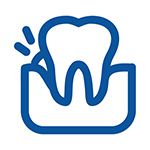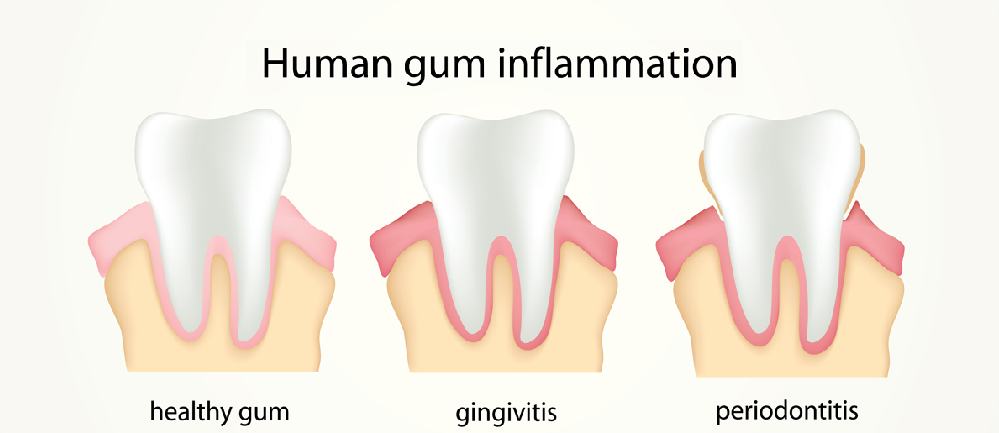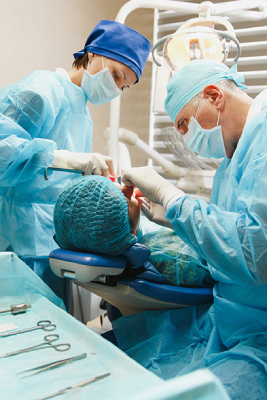

A Periodontics Treatment cures a Periodontal Disease or gum disease or Periodontitis which is caused due to infection in the tissues present in the gum. The gums are responsible for supporting your teeth, therefore if the soft tissue and the bone are destroyed during the gum infection, Periodontitis can lead to teeth loss.
This Periodontal Disease is caused to due to poor oral hygiene such as poor brushing of teeth or irregular flossing habits that cause the plaque, which a harmful bacteria to stick to teeth. If the plaque is not removed or brushed away on time, it hardens over some weeks, forming a “tartar” like material which can only be cleaning via professional methods that your personal Periodontist might use.
This plaque builds, leading to periodontal disease at advanced stages which can cause gum inflammation, bleeding and chewing problems.
There are other risk factors too which are responsible for plaque to build inside the mouth which causes Periodontal Disease. They include:
● Smoking
● Diabetes
● Hormonal changes in girls
● Certain illnesses like HIV/AIDS, Leukemia, Cancer.
● Poor oral health habits
● Smoking or chewing tobacco
● Older age
● Hormonal changes, such as those related to pregnancy or menopause
● Substance abuse
● Obesity
● Nutritional Deficiency, including vitamin C deficiency
● Genetic Susceptibility
● Medications that lessen the flow of saliva
The symptoms of Periodontal Disease can range from mild to severe depending on how serious the gum infection is. Here are the following symptoms of Gum infection/Periodontal Disease:
● Bad Breath that won't go away easily
● Swollen Gyms
● Loose Teeth
● Bleeding gums
● Tender and extra sensitive gums
● Dusky red or purplish gums
● Painful chewing
● Receding gums or longer appearing teeth
● New spaces developing between your teeth
● Pus between your teeth and gums
Once you are diagnosed with gum disease, after your initial consultation with the Periodontist, it would be assessed how severe the gum inflammation is. There are a number of Periodontics Treatment Options but they highly depend on severity of the problem gum disease. The Periodontist may initiate with the least invasive options, which are non-surgical. However, at Advanced periodontal disease, your Periodontist may have to proceed with surgery.
● Scaling: Scaling is responsible for removing plaque from the surfaces of your tooth surfaces as well as under your gums. Scaling may be performed using a laser or an ultrasonic device.
● Root planing: In this type of Periodontics Treatment, the root surfaces are smoothened out so that further buildup of tartar and bacteria is prevented. Root planning will, therefore, remove bacterial byproducts that contribute to gum disease and also delay its healing.
● Antibiotics: Topical or oral antibiotics in the form of mouthwashes, gels or antibiotic tablets can help control bacterial infection.
At Advanced periodontal disease, the ideal Periodontics treatment is surgery. The Surgical Options for Periodontics Treatment include:
● Flap surgery (Pocket Depth Reduction): In this kind of Periodontics treatment, your periodontist makes some tiny cuts into your gums to lift a section of the gum tissue which is then subjected to non-invasive treatments like scaling and root planing.
● Regeneration: At Advanced periodontal disease, you may lose gum tissue which causes your gum-line to recede. To restore this gum area, regeneration treatment is adopted. The Periodontist then places a special piece of biocompatible fabric between existing bone and your tooth
● Soft tissue grafts: The Periodontist begins with folding back the gum tissue where the plaque is cleaned. Then a small amount of tissue from another donor source is implanted to stimulate new bone growth. This reduces the gum recession, which in turn prevents the gum disease.


Globally Trusted Brands
Inquire Now
Get Permanent Teeth in 5 Days
Share Your OPG
Get The Smile You Want, Digitally
Get Invisalign